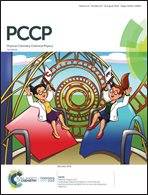Dry reforming activity due to ionic Ru in La1.99Ru0.01O3: the role of specific carbonates†
Abstract
Dry reforming of methane was carried out over La2−2xRu2xO3 (x = 0.005, 0.01). Substitution of just 0.5 atom% of Ru in La2O3 enhanced the activity by 20 times in terms of conversion when compared to the activity exhibited by La2O3. The oxygen storage capacity of the Ru doped sample was considerably higher than undoped La2O3, which resulted in higher conversions of CH4 and CO2. The measured conversion of CH4 and CO2 was 72 and 80%, respectively, at 850 °C. The same was merely 4% with La2O3 under the same experimental conditions. DRIFTS studies demonstrated the role of a specific type of carbonates in promoting the activity of the catalyst. DFT calculations provided the rationale behind the selection of the Ru-in-La2O3 methane dry reforming catalyst. The surface structures of the pure and Ru-substituted compounds were determined, corroborating the experimental observation of enhanced oxygen storage capacity on Ru substitution. Different active surface oxygen species were identified and their roles in improving reducibilities and improving reactivities were established. The experimentally observed surface carbonate species were also identified using calculations. The combined experiment + calculation approach proved ionic Ru in La2−2xRu2xO3 to be a novel and efficient dry reforming catalyst.



 Please wait while we load your content...
Please wait while we load your content...